Products: Spices
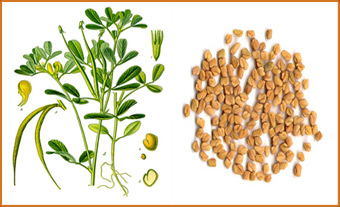 Fenugreek is a plant in the family Fabaceae. Fenugreek is
used both as a herb (the leaves) and as a spice (the seed, often called
methi in Urdu/Hindi/Nepali). The leaves and sprouts are also eaten as
vegetables. The plant is cultivated worldwide as a semi-arid crop and is a
common ingredient in many curries.
Fenugreek is a plant in the family Fabaceae. Fenugreek is
used both as a herb (the leaves) and as a spice (the seed, often called
methi in Urdu/Hindi/Nepali). The leaves and sprouts are also eaten as
vegetables. The plant is cultivated worldwide as a semi-arid crop and is a
common ingredient in many curries.
History
The name fenugreek or foenum-graecum is from Latin for "Greek hay". The plant's similarity to wild clover has likely spawned its Swedish name: "bockhornsklöver" as well as the German: "Bockshornklee", both literally meaning: "ram's horn clover".Zohary and Hopf note that it is not yet certain which wild strain of the genus Trigonella gave rise to the domesticated fenugreek but believe it was brought into cultivation in the Near East.
Production
India is the largest producer of fenugreek in the world where Rajasthan, Gujarat, Uttaranchal, Uttar Pradesh, Madhya Pradesh, Maharashtra,Haryana and Punjab are the major fenugreek producing states. Madhya Pradesh holds one of the key share of India's production, accounting for fenugreek output & quality.Seed
Fenugreek seeds are a rich source of the polysaccharide galactomannan. They are also a source of saponins such as diosgenin, yamogenin, gitogenin, tigogenin, and neotigogens. Other bioactive constituents of fenugreek include mucilage, volatile oils, and alkaloids such as cholineand trigonelline.Fenugreek seeds are used as a medicinal in Traditional Chinese Medicine under the name Hu Lu Ba, where they are considered to warm and tonify kidneys, disperse cold and alleviate pain. Main indications are hernia, pain in the groin. They are used raw or toasted. In India about 2-3g of raw fenugreek seeds (called Methi in India) are swallowed raw early in the morning with warm water, before brushing the teeth and before drinking tea or coffee, where they are supposed to have a therapeutic and healing effect on joint pains, without any side effects.
In Persian cuisine Fenugreek leaves are used and called شنبلیله (shambalile). In Arabic traditional medicine, it is known as حلبه (Helba or Hulba). Tea made from the seeds is used in the Near East to treat various kidney, heart, abdominal illnesses and Diabetes. Seeds are used byBedouin women to strengthen pregnant and breastfeeding women.
Fenugreek is frequently used in the production of flavoring for artificial maple syrups. The taste of toasted fenugreek, like cumin, is additionally based on substituted pyrazines. By itself, fenugreek has a bitter taste.
Fenugreek seed is widely used as a galactagogue (milk producing agent) by nursing mothers to increase inadequate breast milk supply. Studies have shown that fenugreek is a potent stimulator of breast milk production and its use was associated with increases in milk production. [13] It can be found in capsule form in many health food stores.
Several human intervention trials demonstrated that the antidiabetic effects of fenugreek seeds ameliorate most metabolic symptoms associated with type-1 and type-2 diabetes in both humans and relevant animal models by reducing serum glucose and improving glucose tolerance.[15] Fenugreek is currently available commercially in encapsulated forms and is being prescribed as dietary supplements for the control of hypercholesterolemia and diabetes by practitioners of complementary and alternative medicine. Fenugreek contains high dietary fiber, so a few seeds taken with warm water before going to sleep helps avoiding constipation
Use
The cuboid yellow to amber coloured fenugreek seeds are frequently used in the preparation of pickles, curry powders, and curry paste, and the spice is often encountered in the cuisineof the Indian subcontinent.[5] The dried leaves – also called kasuri methi (or kasoori methi in India and Pakistan), after the region of Kasur in Punjab, Pakistan province, where it grows abundantly – have a bitter taste and a characteristically strong smell. When harvested as microgreens, it also known as Samudra Methi, in Maharashtra, especially in and aroundMumbai, Menthium or Venthayam in Tamil, where it is often grown near the sea in the sandy tracts, hence the name (Samudra means "ocean" in Sanskrit).[6] Fenugreek is used in Eritrean and Ethiopian cuisine.[7] The word for fenugreek in Amharic is abesh (or abish), and the seed is used in Ethiopia as a natural herbal medicine in the treatment of diabetes.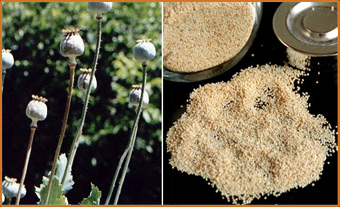 Poppy seed is
an oilseed obtained from the opium poppy (Papaver somniferum). The tiny
kidney-shaped seeds have been harvested from dried seed pods by various
civilizations for thousands of years. The seeds are used, whole or ground, as an
ingredient in many foods, and they are pressed to yield poppyseed oil.
Poppy seed is
an oilseed obtained from the opium poppy (Papaver somniferum). The tiny
kidney-shaped seeds have been harvested from dried seed pods by various
civilizations for thousands of years. The seeds are used, whole or ground, as an
ingredient in many foods, and they are pressed to yield poppyseed oil.
Natural History
Poppy seeds are less than a millimeter in length,[4] and minute: it takes 3,300 poppy seeds to make up a gram, and a pound contains between 1 and 2 million seeds.[1] The primary flavor compound is 2-pentylfuran.To some extent harvesting for poppy seeds is in conflict with harvesting for opium. Poppy seeds of superior quality are harvested when they are ripe, after the seed pod has dried. Traditionally, opium is harvested while the seed pods are green and their latex is abundant, but the seeds have just begun to grow. The seeds of other poppy types are not eaten, but they are cultivated for the flowers they produce. Annual and biennial poppies are considered a good choice to cultivate from seed as they are not difficult to propagate by this method, and can be put directly in the ground in January.[6] TheCalifornia poppy (Eschscholzia californica), for example, is a striking orange wildflower that grows in the Western and Northwestern, United States.
Uses
In Indian cuisine, white poppy seeds are added for thickness, texture and also give added flavor to the recipe. Commonly used in the preparation of korma, ground poppy seed, along with coconut and other spices, are combined as the masala to be added at the end of the cooking step. It is quite hard to grind them when raw, so they are normally dry fried, and then mixed with a little water to get the right paste consistency.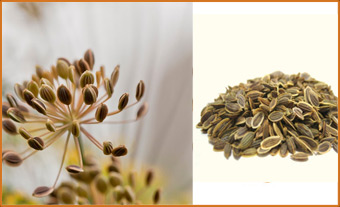 depending on
where it is grown, is either a perennial or annual herb. It is the sole species
of the genus Anethum.
depending on
where it is grown, is either a perennial or annual herb. It is the sole species
of the genus Anethum.
History
Dill originated within an area around the Mediterranean and the South of Russia. "wild and weedy types of dill are widespread in the Mediterranean basin and in West Asia." Although several twigs of dill were found in the tomb of Amenhotep II, they reported the earliest archeological evidence for its cultivation comes from late Neolithic lakeshore settlements in Switzerland.[3] Traces have been found in Roman ruins in Great Britain.Use
Fresh and dried dill leaves (sometimes called "dill weed" to distinguish it from dill seed) are used as herbs, mainly in Finland, Sweden, the Baltic, in Russia, and in central Asia.Like caraway, its fernlike leaves are aromatic and are used to flavor many foods, such as gravlax (cured salmon), borscht and other soups, and pickles (where the dill flower is sometimes used). Dill is best when used fresh, as it loses its flavor rapidly if dried; however, freeze-dried dill leaves preserve their flavor relatively well for a few months.
Cultivation
Successful cultivation requires warm to hot summers with high sunshine levels; even partial shade will reduce the yield substantially. It also prefers rich, well drained soil. The seeds are viable for three to 10 years.The seed is harvested by cutting the flower heads off the stalks when the seed is beginning to ripen. The seed heads are placed upside down in a paper bag and left in a warm, dry place for a week. The seeds then separate from the stems easily for storage in an airtight container.
Medicinal Uses
Dill seeds have spasmolytic properties and they prevent flatulence. They can be used as a herbal tea in the amount of two teaspoons for one glass of boiling water. This herbal tea can be given even to crying infants who cannot sleep because of the spasm of the intestines.Dill was used in many medicines, including medicines against jaundice, headache, boils, lack of appetite, stomach problems, nausea, liver problems, and much more.
- * As a digestive. Chew by itself or with a little sugar to make it more palatable in its raw form.
- * As a cure for diarrhoea, dysentry and indigestion. Boil a cup of water with 1 tbsp of Ajwain till the water is reduced to half its original volume. Drink this water.
- * To relieve symptoms (like blocked nose, etc) of a cold. Add 1 tbsp of Ajwain to a bowl of boiling water and inhale the steam.
- * To ease rheumatic pain. Ajwain oil must be applied on affected part of body.
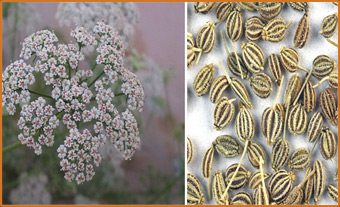 Trachyspermum
ammi, commonly known as ajowan,[1] bishop's weed,[1] ajwain, ajowan caraway,
carom seeds, or thymol seeds, is a plant of India and the Near East whose seeds
are used as a spice.
Trachyspermum
ammi, commonly known as ajowan,[1] bishop's weed,[1] ajwain, ajowan caraway,
carom seeds, or thymol seeds, is a plant of India and the Near East whose seeds
are used as a spice.
History
Ajwain originated in the Middle East, possibly in Egypt and the Indian subcontinent, but also in Iran and Afghanistan. It is sometimes used as an ingredient in berbere, a spice mixture favored in Eritrea and Ethiopia. In India, the major ajwain producing states are Rajasthan and Gujarat, where Rajasthan produces about 90% of India's total production.Flavour and Aroma
Raw ajwain smells almost exactly like thyme because it also contains thymol, but is more aromatic and less subtle in taste, as well as slightly bitter and pungent. Even a small amount of raw ajwain will completely dominate the flavor of a dish. In Indian cuisine, ajwain is almost never used raw, but either dry-roasted or fried in ghee or oil.Uses
Tadka or Tempering is a cooking method in which cooking oil is heated till very hot and whole spices are added to it and fried. This oil and spice mix is then added as a final touch or garnish to the dish. In Indian cooking, Ajwain is often part of the Tadka in a dish. It is used in small quantities and almost always used cooked. This is because of its strong, dominant flavor. Ajwain is also used in vegetable dishes (for its distinctive taste) and pickles (for its preservative qualities). Ajwain has properties that help it reduce the flatulence causing effect of beans. It also aids in digestion.Medicinal uses
It is also traditionally known as a digestive aid, a relief for abdominal discomfort due to indigestion and an antiseptic. In southern parts of India, dry ajwain seeds are powdered and soaked in milk, which is then filtered and fed to babies. Many assume it relieves colic in babies, and for children it also improves digestion and appetite. Ajwain can be used as digestive mixture in large animals. In India, it is often added to heavy fried dishes to aid digestion.A study conducted using the essential oil suggests that it has some use in the treatment of intestinal dysbiosis. Its benefit comes from being able to inhibit the growth of undesired pathogens while not adversely affecting the beneficial flora.
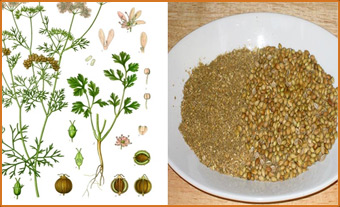 Coriander
is an annual herb and is native to North Africa and Southwest Asia. It is a
soft, hairless, foetid plant growing to 50 cm tall. It is known as cilantro in
the United Sates. All the parts of the plant are edible, but the fresh leaves
and the dried seeds are the most commonly used in cooking. The flavor of the
seeds is warm, mild and sweetish. There is a citrus undertone similar to orange
peel.
Coriander
is an annual herb and is native to North Africa and Southwest Asia. It is a
soft, hairless, foetid plant growing to 50 cm tall. It is known as cilantro in
the United Sates. All the parts of the plant are edible, but the fresh leaves
and the dried seeds are the most commonly used in cooking. The flavor of the
seeds is warm, mild and sweetish. There is a citrus undertone similar to orange
peel. It is a soft, hairless plant growing to 50 centimetres (20 in) tall. The leaves are variable in shape, broadly lobed at the base of the plant, and slender and feathery higher on the flowering stems.
The fruit is a globular dry schizocarp 3–5 mm diameter. While in the English-speaking world (except for the U.S.) the leaves and seeds are known as coriander.
History
Coriander grows wild over a wide area of the Near East and southern Europe, prompting the comment, "It is hard to define exactly where this plant is wild and where it only recently established itself." Coriander seems to have been cultivated in Greece since at least the second millennium BC.Indian Name: Dhaniya
Botanical Name: Coriandrum Sativum.
Family Name: Apiaceae.
Cultivation Zone: Some of the major coriander producing countries are India, Romania, Canada, Pakistan, Bulgaria and Morocco.
Uses
Culinary Uses: Coriander is widely used in varied cuisines for its sweet and armatic bouquet. It is commonly used in Middle Eastern, Mediterranean, South Asian, Latin America, Chinese, African and Southeast Asian cuisines. They are sprinkled like parsley on cooked dishes, minced or puréed in sauces, soups and curries, especially bhuna. Both seeds and leaves can be used in salads. The most common use of coriander seeds is in curry powder. It is also the chief ingredient of garam masala, pickling spices and pudding spices and is used in cakes, breads and other baked foods. It blends well with smoked meats and game and feature in traditional English black pudding recipes and Italian mortadella sausage. Coriander is a characteristic of Arab cookery, being common with lamb, kid and meat stuffings. It adds to fish dishes and with other spices form a delicious coating for spiced fish or chicken. Coriander complements chilli and is included in many chilli recipes, such as harissa, the hot North African red pepper sauce.Medicinal Uses
Coriander has been effective against piles, headache and swellings; the fruit in colic, piles and conjunctivitis; the essential oil in colic, rheumatism and neuralgia; the seeds as a paste for mouth ulceration and a poultice for other ulcers. Its essential oil retards E. Coli growth, suggesting possible agricultural anti-bacterial applications.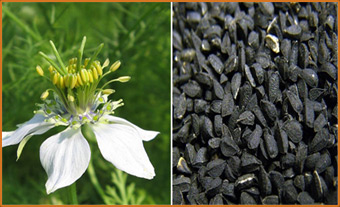 Nigella
sativa is an annual flowering plant, native to south and southwest Asia. It
grows to 20–30 cm (7.9–12 in) tall, with finely divided, linear (but not
thread-like) leaves. The flowers are delicate, and usually coloured pale blue
and white, with five to ten petals. The fruit is a large and inflated capsule
composed of three to seven united follicles, each containing numerous seeds. The
seed is used as a spice.
Nigella
sativa is an annual flowering plant, native to south and southwest Asia. It
grows to 20–30 cm (7.9–12 in) tall, with finely divided, linear (but not
thread-like) leaves. The flowers are delicate, and usually coloured pale blue
and white, with five to ten petals. The fruit is a large and inflated capsule
composed of three to seven united follicles, each containing numerous seeds. The
seed is used as a spice.
History
According to Zohary and Hopf, archeological evidence about the earliest cultivation of N. sativa "is still scanty", but they report supposed N. sativa seeds have been found in several sites from ancient Egypt, including Tutankhamun's tomb.[4] Although its exact role in Egyptian culture is unknown, it is known that items entombed with a pharaoh were carefully selected to assist him in the afterlife. The earliest written reference to N. sativa is thought to be in the book of Isaiah in the Old Testament, where the reaping of nigella and wheat is contrasted (Isaiah 28: 25, 27).Characterstic
Nigella sativa has a pungent bitter taste and smell. It is used primarily in confectionery and liquors. Peshawari naan is, as a rule, topped withkalonji seeds.Uses
* Pickles.* Diabetes.
* Inhibition of cancer cell growth.
* Improvement of the Immune System.
* Viral Infections.
* Psoriasis.
* Asthma
Common name
In English, Nigella sativa seed is variously called fennel flower, nutmeg flower, Roman coriander, blackseed or black caraway. Other names used, sometimes misleadingly, are onion seed and black sesame, both of which are similar-looking, but unrelated.The seeds are frequently referred to as black cumin (as in Assamese: kaljeera or kolajeera orBengali kalo jeeray), In south Indian language Kannada it is called "Krishna Jeerige", but this is also used for a different spice, Bunium persicum (= Carum bulbocastanum).[2]
In English-speaking countries with large immigrant populations, it is also variously known askaljeera (Assamese কালজীৰা kalzira or ক’লাজীৰা kolazira), kalo jira (Bengali: কালোজিরা kalojira, black cumin), karum cheerakam (Tamil கருஞ்சீரகம்), kalonji (Hindi/Urdu कलौंजी kalauṃjī or كلونجى/कलोंजी kaloṃjī) or mangrail (Hindi मंगरैल maṃgarail), ketzakh (Hebrew קצח), chernushka (Russian), çörek otu (Turkish), habbat al-barakah (Arabic حبه البركة ḥabbat al-barakah, seed of blessing), siyah daneh (Persian سیاهدانه siyâh dâne), jintan hitam (Indonesian), karim jeerakam in Malayalam or කළුදුරු in Sinhala, Karto Jeera in (Beary Language)
Categories
- Lin Seeds
- Soya Bean Seeds
- Mustard Seeds
- Wheat Seeds
- Fenugreek Seeds (Methi)
- Dill Seeds (Suwa)
- Carom Seeds (Ajwain)
- Coriander Seeds (Dhaniya)
- Nigella Sativa (Kalonji)

